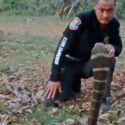There’s that oh-so-familiar sound off in the distance. It seems pretty far away, so there’s not much to worry about. Wait! It’s getting louder. Should I run? Stay? Oh no, it’s too late!
They will snatch a honeybee out of the air, viciously biting off its head and bringing it back to their nest for their young to feed on. Just a few dozen of these can decimate thousands in only a few short hours. The Asian giant hornet, known as the murder hornet.
Could these beasts murder you? How could you escape their wrath? If they might be in the neighborhood, what can you do to protect yourself?
Step 1: Stay away
Murder hornets don’t usually attack humans. However, they are considered an apex predator at the top of the food chain. They are very aggressive when it comes to other insects. That’s where their murderous reputation comes from. But we are not entirely off the hook, so it’s essential to avoid them at all costs. These Asian hornets can be found in low altitude, wooded areas, building their nests in the ground. Murder hornets will attack sites containing honeybees. If you happen to wander into this territory while they are stalking their next victims, well, that leads us to step 2.
Step 2: Run
Run away as fast as you can. Cover your face, and seek shelter. If you have to jump in the water, hopefully, you can hold your breath for a very long time. Because these flying honey badgers will lie in wait until you surface. But, before it gets this bad, murder hornets can display a warning, so be aware. If you see them flying back and forth, snapping their mandibles, or jaws, that’s a surefire sign warning your in imminent danger. It shouldn’t be too difficult to notice what they’re doing, because these things are enormous.
Murder hornets are the largest hornet globally, with queens growing up to 5 cm (2 in) long. with wingspans topping 7 cm (2.8 in). A bug this big could be an easy target to just swat away but don’t. Don’t even think about it. This will only make them angry, and draw more of them to you. Murder hornets are incredible fliers, reaching speeds of up to 32 km (20 mph). So if more show up, the odds are stacked against you, and the last thing you want is to experience the excruciating pain of the murder hornets’ sting. And if this happens?
Step 3: Treat the sting immediately
First of all, getting stung by a murder hornet is like getting punctured by a red hot nail, due to their long stingers. The amount of venom a giant hornet can inject is 1,100 mcg (0.0002 tsp). This venom carries neurotoxins that can kill red blood cells and dissolve skin. It also has kinins, which dilate blood vessels, mastoparan, a toxin, and phospholipase which breaks down immune cells and causes widespread inflammation.
Combining these together creates a deadly cocktail that can degrade blood and muscle cells. This can stop your kidneys from working.. If you’re not allergic to bee stings, you’d need to be stung by a couple of hundred murder hornets before the toxin kills you. And that could happen. If you can’t escape, murder hornets won’t stop with one sting. They’ll continue to relentlessly sting away, until they’re satisfied you’re no longer a threat. Talk about holding a grudge.
Okay, now that you know what is going on in your body, and you fled the area, treat a murder hornet sting like a normal bee or wasp sting. And don’t rub the spot where you’ve been stung, as that will spread the venom. Apply ice or a cold compress to the site to lessen inflammation, and slow the spread of venom. Seek medical attention. You may seem fine, but don’t risk having a bad reaction to the venom. Nathaniel Peterson provoked a murder hornet into stinging him, and described more than a day of searing pain and changed to a constant itching. His arm swelled up like a hot dog.
Step 4: Wear protective clothing
If you know in advance that you could be encountering these flying giants, you’ll want to make sure you’re wearing the right clothing. Beekeepers and researchers working with Asian hornets wear protective clothing like thick sweatshirts and a beekeeper’s suit to avoid a hornet’s stinger penetrating their skin.
Sources
- “Cutaneous hemorrhage or necrosis findings after Vespa mandarinia (wasp) stings may predict the occurrence of multiple organ injury: A case report and review of literature”. 2020. Clinical Toxicology.
- “Why are ‘murder hornet’ stings so intense?”. Douglas, Main. 2020. Animals.
- “Just How Dangerous Is the ‘Murder Hornet’?”. Embry, Paige. 2020. Scientific American.
- “Could murder hornets survive in Ontario?”. Leah, Gerber. 2020. thestar.com.
- “Another ‘murder hornet’ found in Washington State—here’s what that means.”. 2020. Animals.
- “What you need to know about ‘murder hornets’”. 2020. Science News For Students.



























